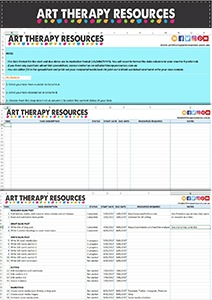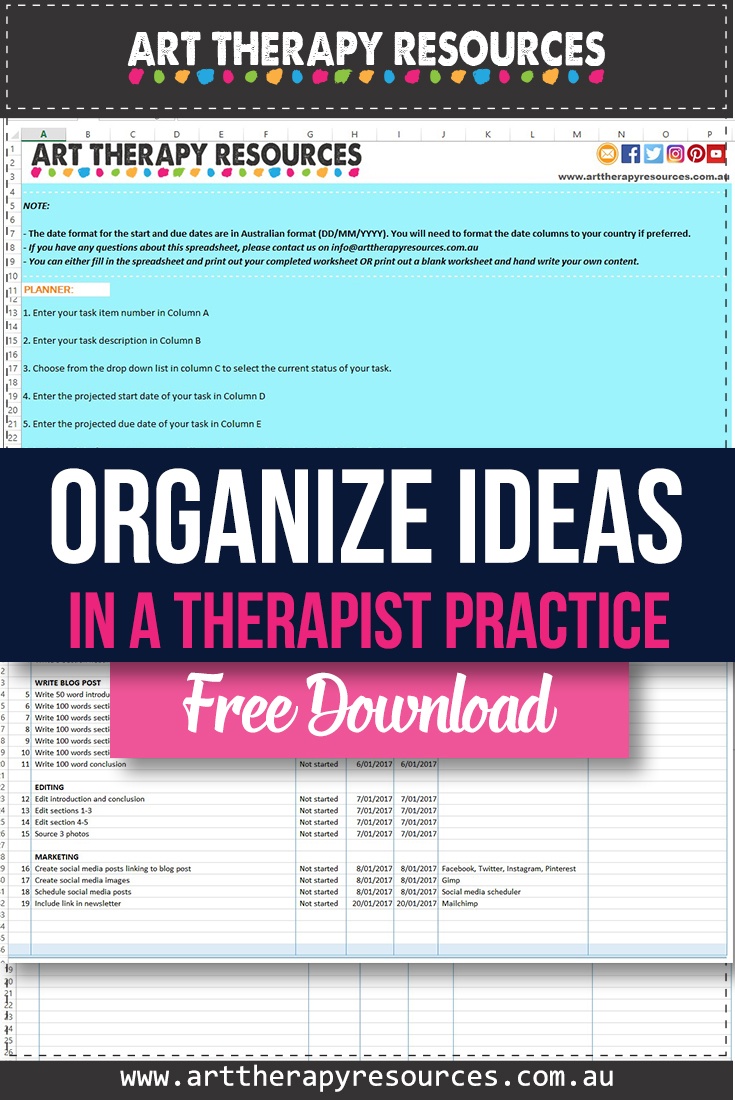THIS POST INCLUDES:
1. Identify ideas for your private practice
2. Focus on the important ideas
3. Tools to help organize your ideas
4. Free Download Planning Template
IDENTIFY IDEAS FOR YOUR PRIVATE PRACTICE
As a therapist working in private practice, you will no doubt feel the pressure of managing the multiple facets of your practice. This includes client work, business management, and professional development.
Fortunately in a modern working world, technology can help us identify and manage these many facets of our private practice.
If you’re new to private practice, the most confusing part of managing your practice will be identifying what needs to be managed first. While universities and colleges cover how to deliver client work, they often don’t provide classes on business administration or marketing your practice.
The most important aspects of your private practice can be categorised as below:
1.Client work
2.Business management
3.Professional development.
Focusing on these three important categories ensures your clients are taken care of, your private practice is managed, and your professional skills are developed.
Within these three key areas, you can develop subcategories to help further identify key aspects of your private practice.
Some subcategories include:
- Client work
- Appointments
- Client paperwork
- Business management
- Administration
- Marketing
- Professional development
- Additional therapeutic skills
- Develop personal brand eg, write a book, conference talks etc
The level of categories that you develop will depend on the areas you wish to focus on in your practice. You may wish to solely focus on client work or you may wish to develop external sources of income that involve writing a book or giving talks on mental health issues.
You should identify the most important areas of your business that provide the most immediate pay off for operating your private practice. As your private practice becomes stable, you can expand the services that you offer and the different avenues you want to explore professionally.
The path for how you develop your private practice should reflect the resources you have available to invest in your private practice. As you gain momentum in growing your private practice, you will have more resources available that you can direct back into developing your private practice even further.
FOCUS ON THE IMPORTANT IDEAS
Productivity experts suggest that we are at our most productive when we focus on a limited number of tasks. Recent research indicates that we are not able to multi-task as well as we think we can. Often when we multi-task we are juggling many ideas adequately, however, we may not be progressing our most important ideas as successfully as we possibly can.
As a private practitioner deciding on the most important ideas can be difficult. If you are working in someone else’s practice then your primary focus is delivering client care. However, as a private practitioner, you have additional responsibilities that involve managing your private practice to ensure you have a business that can provide client care.
As your private practice grows your focus will change over time. In the beginning, your focus will be on establishing a client base that provides a consistent income. When you don’t have any clients, your focus will be on marketing efforts, however, as you gain more clients, your attention will be diverted away from marketing and toward providing client care.
This can create tension and stress in learning how to manage these different areas of your private practice. This highlights the importance of looking forward to your next stage of growth and implementing future growth tasks in the present so that they work for you with minimal effort in the future.
To illustrate this point, imagine you are a new practice with minimal clients. Therefore your time can be spent on marketing and administrative tasks while your client load is small. Instead of using this time to only create marketing plans for the present moment, use this time to create marketing plans for 12 months into the future. This could involve creating and scheduling social media posts for 12 months or creating four different advertisements for your practice and rotating them over 12 months.
One of the most important aspects of implementing any idea or plan is to ensure that you give adequate time to reviewing and assessing how effective your idea was and whether it contributed to achieving your overall goals.
Once you undertake a review, you can change and adapt to new growth in your business so that you stay focused on your main goals of client care, business management, and professional development.
TOOLS TO HELP ORGANIZE YOUR IDEAS
Planning is the foundation for pursuing your art therapy business goals. Once your goals are set, you need a system in place to help facilitate action. This is where using the right planning tools can help you improve your art therapy business in a variety of ways.
1. Spend less time on repetitive tasks
2. Provide a clear direction for your business
3. Keep you motivated
4. Improve decision making
5. Improve the quality of content
6. Convert your goals into achievements
7. Keep your business organised
8. Present your business goals in a simplified format
9. Help define resources needed to achieve goals
10. Provide a method of measuring your goals
The type of planning tools you use will depend on the activities you engage in with your business. If you only deliver therapy services then you can choose tools that help plan appointments and client management.
If you also write blog content, sell ebooks, and conduct workshops online, there are many tools that are specific to those tasks. There are tools that help you create comprehensive plans in different areas of your art therapy business using one application.
When organising your ideas it helps to think about the process of managing the ideas you initially think of as well as executing the idea. This process can be broken down into the following important categories:
- Plan – identify your ideas and formulate a plan to execute them
- Capture – capture your ideas and supporting information that will help you to execute your idea
- Implement – use a process of checklists, templates, and review to implement your ideas
- Use templates – use templates where possible so the process can be quality checked and repeated in the future
Some software that will assist in this process of organising and implementing your ideas is listed below:
You can read more about each program in our previous blog post: 10 Useful Planning Tools for Your Business
Further reading:
For more articles that relate to planning and organizing within your therapy practice, check out our previous blog posts listed below:
- 10 Tools to Help Boost Your Productivity
- 10 Useful Planning Tools for Your Business
- How to Plan A Productive Year as a Therapist
- Planning Template for Your Art Therapy Practice
- Smarter Faster Better: The Transformative Power of Real Productivity
- Task Management Software For Art Therapy Planning
- The Power of Habit: Why We Do What We Do in Life and Business
FREE DOWNLOAD: Planning Template
SIGN UP below to download the FREE Excel Planning Template to use for your next project.

BUILD YOUR ART THERAPY REFERENCE MATERIALS:
Pin this image to your Pinterest board.

SHARE KNOWLEDGE & PASS IT ON:
If you’ve enjoyed this post, please share it on Facebook, Twitter, Pinterest. Thank you!
